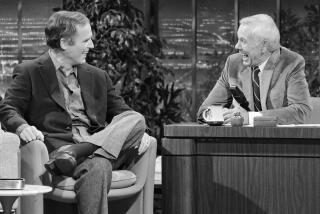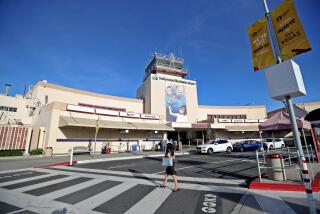WiFi mission to Burbank
PRECARIOUSLY juggling a 5-year-old laptop and a steaming hot latte, I waded through the chairs of leisurely newspaper readers, chatty moms and wannabe screenwriters to secure a spot at Starbucks in downtown Burbank. The triple attraction of espresso, air conditioning and the chance for free wireless Internet service had lured me in on a muggy July morning.
Like an increasing number of cities across the nation, Burbank offers residents and visitors free wireless in most of downtown. Twelve access points -- with nine more to come in the next few months -- allow anyone downtown with a wireless card or WiFi-ready computer to surf the Web. But does it deliver? I ventured into the 818 wilderness to find out.
With trepidation, I flipped open my laptop and waited to see if it would connect to the network. My wireless card felt Starbucksâ unfree signal the strongest, at 35%. The downtown signal -- the free stuff -- measured 13%. I could almost imagine my computer croaking, âCan you hear me now?â
Unsatisfied with the weak signal, I assessed the landscape. There was an open seat at 10 oâclock. I pounced. The free signal came in at 31% -- enough for a decent connection. With laser-quick speed, I was able to fire off a few e-mails, watch the latest âColbert Reportâ on YouTube and oh, right, do some work.
I ventured outside to continue my investigation. Inside another cool watering hole, a shop offering pearl tea, the signal was clear and strong. But at an outdoor bench two blocks away, my wireless card couldnât forge a connection. With locals shooting concerned looks in my direction -- and the threat of the fiercest predator on the Burbank plains, the parking enforcement officer, nearing my car -- I ended my quest. Free wireless, Iâve so far gleaned, is a little harder to hunt down than one would be led to believe.
As anyone with a home wireless network can attest, they are finicky. Add a source of interference (a microwave oven, certain types of building materials, cellphones, small pets) and connectivity suffers. On a larger scale, sources of interference multiply.
Now some cities that want to jump into the wireless game are facing a larger obstacle: Southern California Edison. The utility has yet to cede control of its utility poles in many areas, making it difficult for municipalities to set up networks. Undeterred, cities are crafting creative solutions. Diamond Bar, for instance, may use the power of eminent domain to claim a foot of space atop 450 of Edisonâs 5,000 poles in the city to place its transmitters.
Cities claim that it is worth the trouble. Free wireless has the potential to attract customers and businesses, boosting the local economy. Yet rushing to install systems that could become quickly outdated is a risky proposition -- and even whatâs available, as my mission concluded, is by no means perfect.
The arrival of WiMAX, a wireless technology that could blanket an area of several miles, could render some current WiFi systems obsolete. Even perfect signals could spell trouble for unsuspecting consumers. Unless she has installed a firewall, for instance, that screenwriter sitting across from me at Starbucks could have her entire script snatched away by a sharp hacker.
Thereâs no denying it: Free wireless is about as fabulous as central air conditioning in the Valley on a scorching summer day. But there is still a ways to go before I can surf the Web and Google myself while breezing through traffic in downtown Burbank.
Not that I would ever do that. Google myself, I mean.
*
Michelle Keller
More to Read
Sign up for Essential California
The most important California stories and recommendations in your inbox every morning.
You may occasionally receive promotional content from the Los Angeles Times.










